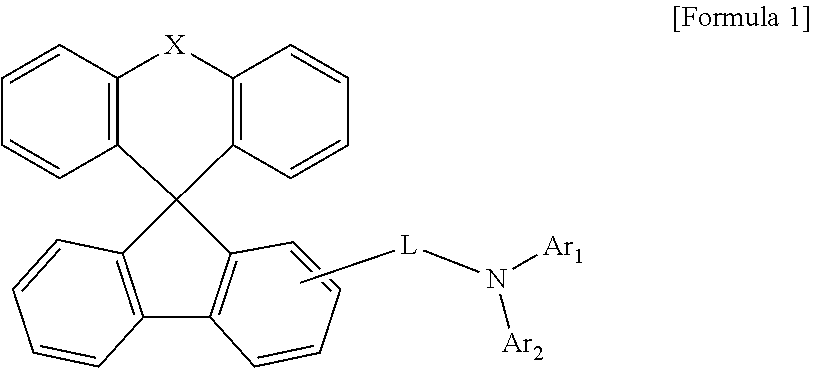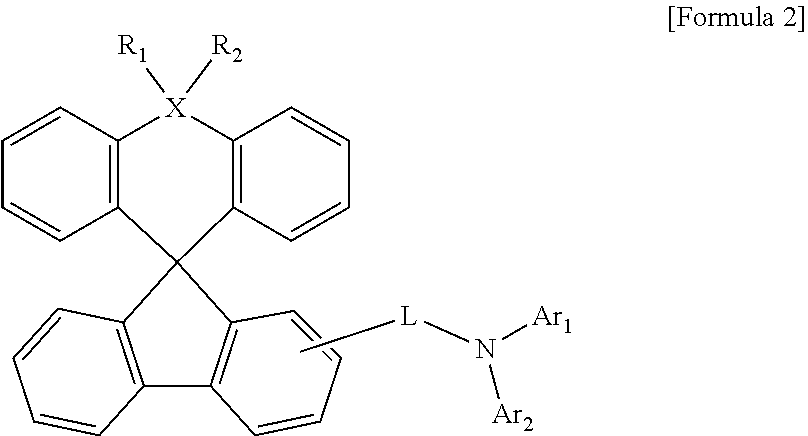Organic light-emitting compound and organic electroluminescent device using the same
- Summary
- Abstract
- Description
- Claims
- Application Information
AI Technical Summary
Benefits of technology
Problems solved by technology
Method used
Image
Examples
preparation example 1
[Preparation Example 1] Synthesis of 2′-(4-chloronaphthalen-1-yl)-10,10-dimethyl-10H-spiro[anthracene-9,9′-fluorene]
[0082]
[0083]200 mL of toluene, 50 mL of EtOH and 50 mL of H2O were added to 15.0 g (38.2 mmol) of 2′-chloro-10,10-dimethyl-10H-spiro[anthracene-9,9′-fluorene] and 9.5 g (45.9 mmol) of (4-chloronaphthalen-1-yl)boronic acid. 2.3 g (2.0 mmol) of Pd(PPh3)4 and 10.6 g (76.4 mmol) of K2CO3 were added thereto, followed by heating under reflux at 100° C. for 3 hours. The reaction was terminated by lowering the temperature to room temperature and adding 300 mL of purified water to the reaction solution. The reaction mixture was extracted with 1.0 L of ethyl acetate (EA) and then washed with distilled water. The obtained organic layer was dried with anhydrous MgSO4, distilled under reduced pressure, and purified by silica gel column chromatography to obtain 12.3 g (62% yield) of the desired compound.
[0084][LCMS]: 519
preparation example 2
[Preparation Example 2] Synthesis of 3′-(4-chloronaphthalen-1-yl)-10,10-dimethyl-10H-spiro[anthracene-9,9′-fluorene]
[0085]
[0086]19.5 g (49%) of the desired compound was obtained by performing the same process as Preparation Example 1, except that 3′-chloro-10,10-dimethyl-10H-spiro[anthracene-9,9′-fluorene] was used as the reactant.
[0087][LCMS]: 519
preparation example 3
[Preparation Example 3] Synthesis of 4′-(4-chloronaphthalen-1-yl)-10,10-dimethyl-10H-spiro[anthracene-9,9′-fluorene]
[0088]
[0089]20.4 g (69%) of the desired compound was obtained by performing the same process as Preparation Example 1, except that 4′-bromo-10,10-dimethyl-10H-spiro[anthracene-9,9′-fluorene] was used as the reactant.
[0090][LCMS]: 519
PUM
| Property | Measurement | Unit |
|---|---|---|
| Electric potential / voltage | aaaaa | aaaaa |
| Electric potential / voltage | aaaaa | aaaaa |
| Luminous efficiency | aaaaa | aaaaa |
Abstract
Description
Claims
Application Information
 Login to View More
Login to View More - R&D
- Intellectual Property
- Life Sciences
- Materials
- Tech Scout
- Unparalleled Data Quality
- Higher Quality Content
- 60% Fewer Hallucinations
Browse by: Latest US Patents, China's latest patents, Technical Efficacy Thesaurus, Application Domain, Technology Topic, Popular Technical Reports.
© 2025 PatSnap. All rights reserved.Legal|Privacy policy|Modern Slavery Act Transparency Statement|Sitemap|About US| Contact US: help@patsnap.com



